After pulling back post-Q2, Polish equities have rallied strongly in the leadup to the recent parliamentary election. The positive market reaction continued post-election, with a coalition government comprising opposition parties Civic Coalition, Third Way, and the Left now the most likely outcome, having received a combined majority of over 50% of parliament.
While I agree with expectations for a more hawkish (or less dovish) Polish central bank helping bank margins, the ex-financials iShares MSCI Poland ETF (NYSEARCA:EPOL) portfolio could suffer without the lower rate tailwind. Plus, a more left-leaning new government may favor less shareholder-friendly policies like higher corporate taxes (including wealth taxes on certain industries), as well as strategic changes at state-controlled companies to help finance the budget deficit.
At ~7x earnings, EPOL screens cheaply at first glance, but relative to consensus expectations for low-single-digit percentage declines through 2024 and lingering political uncertainty (formation of a new government is likely only by next year), I don’t see compelling value here.
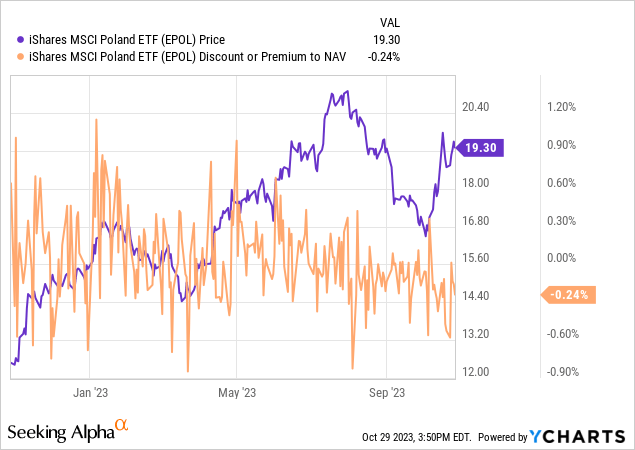
Fund Overview – Competitively Priced Polish Large-Cap Vehicle
The iShares MSCI Poland ETF tracks the total return (price and yield performance) of the MSCI Poland IMI 25/50 Index, a basket of Polish large-caps subject to weighting constraints (less than 25% of assets invested in a single issuer and less than 50% limit for cumulative holdings over 5%). The fund has seen its net asset base expand slightly this year and currently manages $209m at an expense ratio of 0.58% (unchanged). The ETF is priced competitively, given the scarcity of Polish large-cap investment vehicles available to US investors.
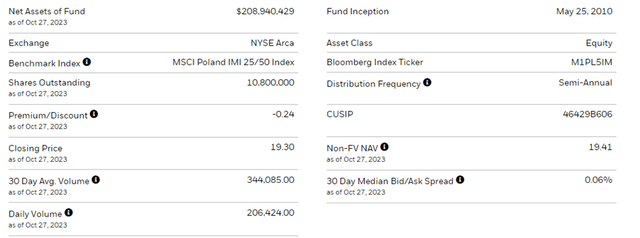
iShares
The EPOL portfolio has narrowed slightly over the last year to 31 stocks. The top holding remains Polish oil refiner and petrol retailer PKN Orlen (OTC:PSKOF), albeit at a reduced 12.7% of the portfolio. The second-largest holding is PKO Bank Polski at an increased 12.1%, followed by Polish insurance leader PZU SA (OTCPK:PZAKY) at 9.2% and Bank Pekao (Poland’s second-largest bank) at 7.3%.

iShares
The increased financial concentration (44.6% of EPOL) is largely due to Polish banks rallying in anticipation of monetary policy normalization post-election. Helped by Orlen’s stock price recovery this month, the energy sector also remains a major contributor at 12.7%. In aggregate, the fund’s fortunes remain closely tied to a few major sectors (Financials, Energy, and Consumer Discretionary represent ~68% of EPOL), so investors should be aware of the concentration risks here.

iShares
Fund Performance – A Surprise YTD Outperformer; Longer-Term Track Record Remains Subpar
On a YTD basis, EPOL has now returned +25.4%, boosting its total one-year return to +62.2%. To an extent, the one-year return figure benefits from a favorable base effect – 2022 saw one of the steepest drawdowns on record at -24.5%. Over longer timelines, the fund has offered disappointing returns for investors, annualizing at -4.7% and -3.0% over the last five and ten years, respectively. Since its inception in 2010, the fund has returned a cumulative +0.1%, virtually unchanged and far underperforming broader European funds like the US-listed iShares Europe ETF (IEV).
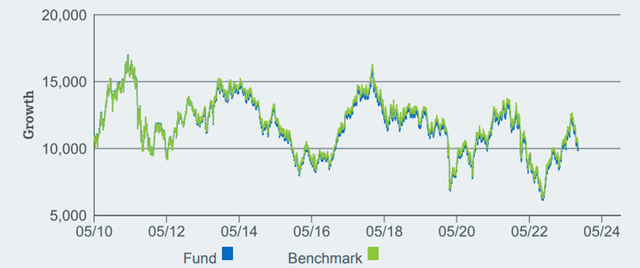
iShares
The fund’s distribution (paid on a semi-annual basis) yield has also declined to 1.6% on a trailing twelve-month basis despite EPOL’s outsized exposure to two cash-generative sectors (energy and financials) that typically offer good payouts. Going forward, names exposed to the broader oil/commodities cycle, such as top-holding Orlen, could also see further cuts to their payouts in the likely event that we enter a cyclical downswing. Meanwhile, Poland’s steeper-than-expected rate cut cycle this year has been a headwind to bank margins, potentially offsetting earnings elsewhere in the EPOL portfolio. On balance, EPOL isn’t an ideal fund for the income-oriented.
Thinking Through Post-Election Implications for Polish Equities
With Poland’s opposition coalition gaining victory this month, the path is now clear for its central bank, the NBP (“Narodowy Bank Polski”), to pull back on its ultra-dovish stance. Recall that the monetary policy committee had begun a series of rate cuts this year, culminating in a cumulative 100bps cut in September (-75bps) and October (-25bps). The post-meeting press conference was dovish as well, leaving the door open for further monetary easing going forward – despite inflation still running well above target.
That said, the incentive for policy easing will ease now that the election is done and dusted, and thus, I would expect policy rate cuts to be better aligned with inflation trends from here. Given real rates are currently negative in Poland and have diverged considerably from other countries in the region, this points to a more neutral policy stance by NBP Governor Glapinski, who retains his mandate through 2028.
While a more hawkish central bank will be favorable for rate-sensitive Polish banks, valuation gains for the rest of the market should slow – in contrast with bullish market expectations post-election.
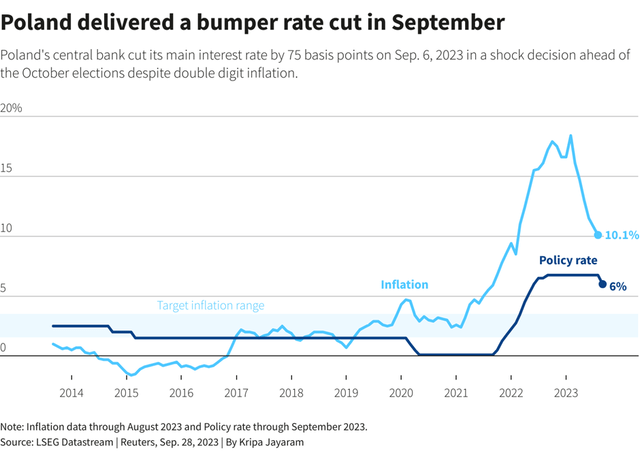
Reuters
As many of EPOL’s key holdings are state-controlled (most notably Orlen), a shift in government towards the left will also have significant governance implications.
One key development to look out for is the increased possibility of windfall taxes (floated by both sides pre-election) being imposed, with state-controlled Orlen likely first in line, having benefited from a cyclical upswing in recent years.
Also worth watching out for is the risk to its high-single-digit dividend yield, as well as its mid-term capex plans, which may be amended according to the new government’s budget priorities. EPOL’s banking concentration is a risk as well, given the sector’s profitability could invite one-off taxes to shore up the country’s fiscal position (currently in deficit).
The most likely near-term outcome, though, is a standstill, as the process of forming a new government will take a few months, and current President Andrzej Duda, who retains veto power, will remain in office through mid-2025. Either way, I see more downside than upside from here.
Beware the Polish Post-Election Rally
Having recovered most of its Q3 losses in September, the risk/reward for Polish equities isn’t ideal, in my view. Standalone valuations are cheap for EPOL (7x P/E and 1.1x P/B), but rightly so, given consensus negative earnings growth estimates through next year.
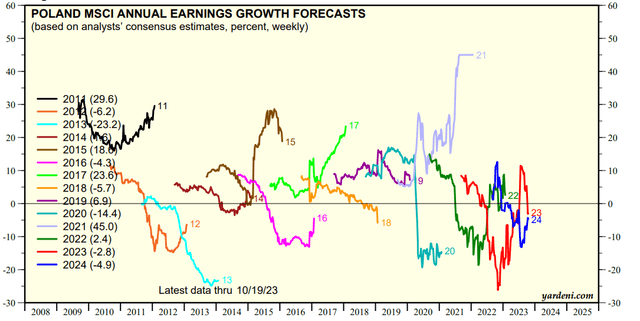
Yardeni
Plus, there’s still post-election uncertainty, as the opposition coalition is now likely to form a government, the process isn’t a straightforward one, with incumbent President Duda retaining veto power until 2025. Expect potentially unfavorable changes at state-controlled companies as well, particularly for EPOL’s largest holding, Orlen. And with the monetary policy tailwind that buoyed ex-financial stocks this year now set to fade as the NBP normalizes its ultra-dovish reaction function in line with inflation, I don’t see a compelling reason to own Polish large-caps here.
Read the full article here



